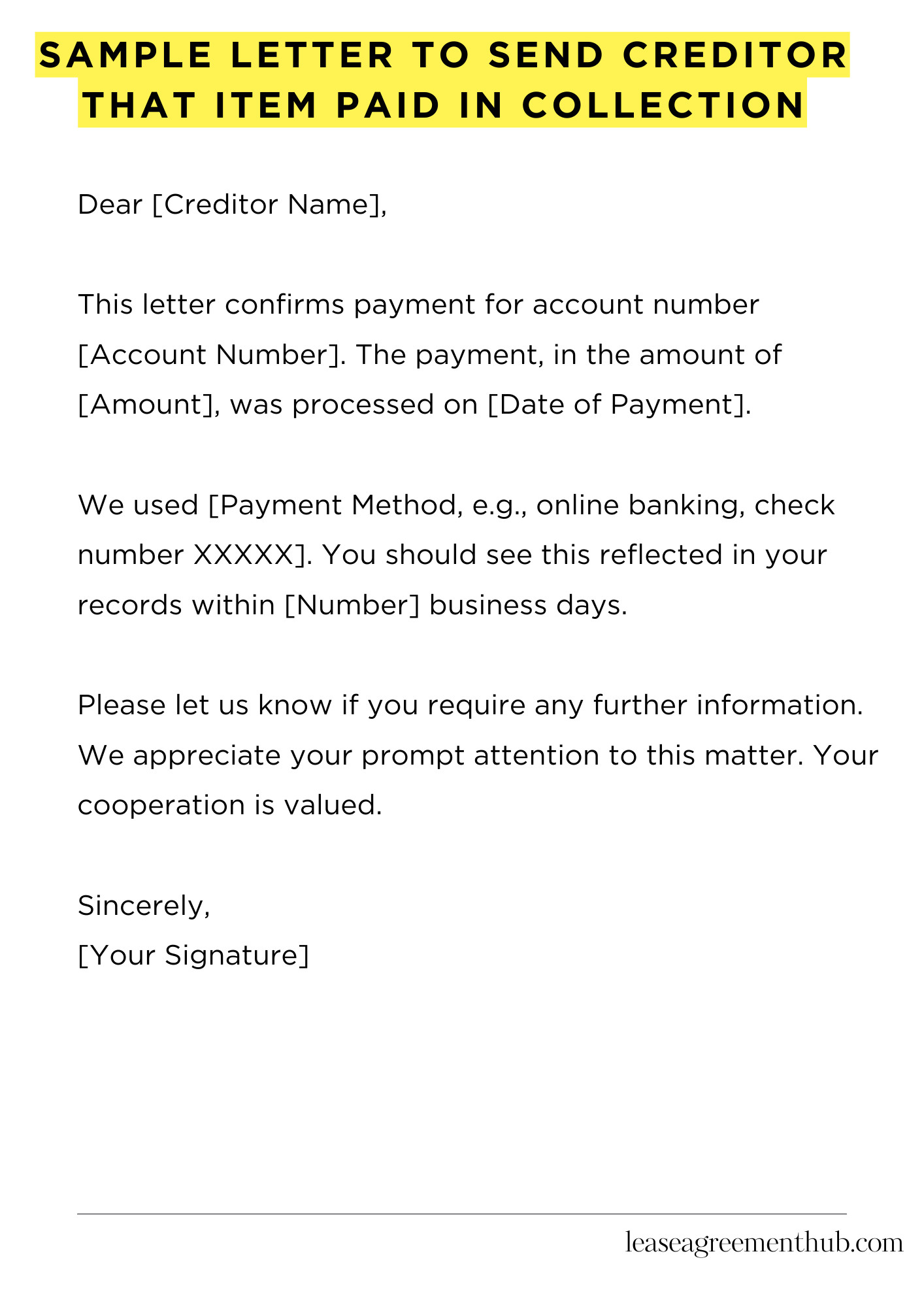Dealing with collections can be stressful. A letter proving payment is crucial. It protects you.
This article gives you helpful examples. These are sample letters. They show you what to write. We offer different options.
Use these templates. Write your own effective letter. Get your debt resolved quickly.
sample letter to send creditor that item paid in collection
[Your Name]
[Your Address]
[Your Phone Number]
[Your Email Address]
[Date]
[Creditor Name]
[Creditor Address]
Dear [Creditor Name],
This letter confirms payment for account number [Account Number]. The payment, in the amount of [Amount], was processed on [Date of Payment]. We used [Payment Method, e.g., online banking, check number XXXXX]. You should see this reflected in your records within [Number] business days.
Please let us know if you require any further information. We appreciate your prompt attention to this matter. Your cooperation is valued.
Sincerely,
[Your Signature]

How to Write a Sample Letter to Send Creditor That Item Paid in Collection
Understanding the Nuances of Debt Resolution
Successfully navigating debt resolution requires meticulous documentation. A seemingly simple payment can become entangled in bureaucratic processes without clear communication. This letter aims to provide a definitive record of your payment, leaving no room for ambiguity.
Crafting a Persuasive Salutation
Begin with a formal salutation, addressing the creditor by name and title if known. Using “Dear Sir/Madam” is acceptable if specifics are unavailable, but a personalized approach always demonstrates greater probity. Avoid overly familiar or informal greetings.
Clearly Stating Your Account Details
Unmistakably identify your account. Include your full name, account number, and any other relevant identification numbers provided on your statements. This precise identification prevents misallocation and ensures the payment is applied correctly. Omitting this crucial information invites protracted delays.
Providing Irrefutable Proof of Payment
This is the linchpin of your letter. Specify the date of payment, the method used (check, money order, online transfer), and the amount paid. Include any transaction reference numbers or confirmation codes. Attach copies of bank statements or payment confirmations as irrefutable evidence. Such probative documentation strengthens your claim considerably.
Requesting Confirmation and Acknowledgment
Politely request written confirmation that the payment has been received and applied to your account. This proactive step safeguards against future disputes. State a reasonable timeframe for expecting a response to avoid unnecessary follow-up.
Maintaining a Professional Tone Throughout
Keep the language formal and professional. Avoid emotional language or accusatory statements. Maintain a courteous tone, even if you have experienced difficulties with the creditor in the past. A measured and polite approach is generally more efficacious.
Concluding with Contact Information and a Valediction
Conclude with your contact information (phone number, email address, and mailing address). Use a formal closing such as “Sincerely,” or “Respectfully,” followed by your typed name. A legible signature adds a personal touch. This closing statement completes the epistolary exchange formally.
FAQs about sample letter to send creditor that item paid in collection
Sending a letter to a creditor confirming payment of a debt in collections requires clarity and precision. This FAQ section addresses common concerns regarding such correspondence.
What information should I include in my letter?
Your letter should clearly state the account number, the amount paid, the date of payment, and the method of payment (e.g., check number, transaction ID). Include your name and address, and a copy of your proof of payment (receipt, bank statement excerpt, etc.) is highly recommended.
How formal should the tone of my letter be?
Maintain a professional and courteous tone. While you can be firm in stating that the debt is paid, avoid accusatory or aggressive language. A polite and respectful approach is more likely to yield a positive response.
What if I don’t have proof of payment?
If you lack proof of payment, your letter should still clearly state the date and amount of the payment. Explain the circumstances of why you don’t have documentation. Contacting your bank or payment processor for assistance in obtaining a record is advisable. Be prepared to provide additional information to verify your claim.
What should I do if the creditor disputes the payment?
If the creditor disputes your payment, immediately gather all supporting documentation, including the letter you sent and any proof of payment. Maintain detailed records of all communication with the creditor. You may need to contact your bank or payment processor to obtain additional verification. Consider seeking advice from a consumer credit counselor or legal professional if the dispute is not resolved.
Should I send the letter via certified mail?
Sending your letter via certified mail with return receipt requested provides proof that the creditor received your correspondence. This added layer of protection is recommended, especially if the amount in question is substantial or if you anticipate potential complications.
Related: